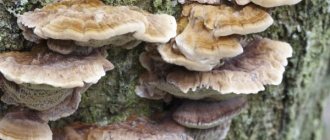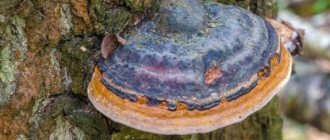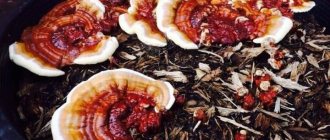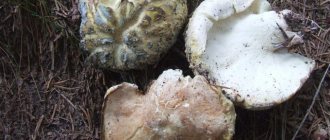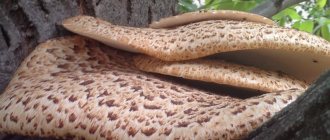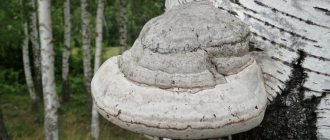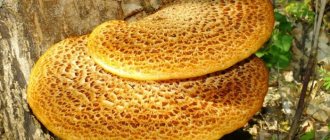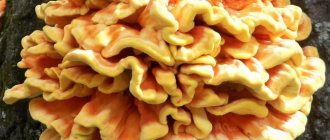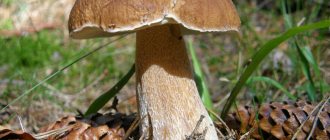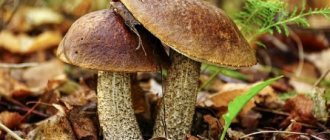Tinder fungus: description
After a certain, usually laconic, period of growth and development, the two primary mycelium unite to form a secondary binucleate mycelium, which develops in the wood, causing its destruction, and on which fruiting bodies are later formed.
The vegetative mycelium of polypores ensures their distribution in the substrate and nutrition.
The hyphae of tinder fungi are thin (2–5 µm in diameter), dull or sometimes brownish, always with transverse septa.
Use in folk medicine and recipes
Polypores are actively used in Eastern medicine to treat almost any ailment. Using traditional methods, you can heal serious diseases, including oncology. The patient is offered to drink tinctures of water, vodka, or decoctions with the addition of other ingredients. Some recipes require dried mushrooms. They are ground to a powder state and used for vitamin deficiency, dermatological problems, and for general strengthening of the body. For the treatment of oncology, a tincture of mushrooms and vodka is prepared.
Adenoma is a serious disease that can develop into cancer. For prevention, use a decoction of tinder fungus. To prepare, add 2 tbsp to water (volume 0.5 l). dry mushroom powder. Cook the mixture for 1 hour, cool, strain. Drink 200 ml twice a day.
Fruiting body of tinder fungus
The fruiting bodies of tinder fungi, unlike cap mushrooms, are long-lived.
Their anatomical structure is quite simple - they consist entirely of hyphae, of which there are three main types: generative, skeletal and connecting.
According to their shape, the fruiting bodies of tinder fungi can be divided into the following main categories: prostrate, sessile and differentiated into a cap and a stalk.
But there are various transitions between them, and within the boundaries of the first family and even genus, fruiting bodies of various shapes can be observed.
Differences in the fruiting bodies of the tinder fungus
The prostrate fruiting bodies of polypores have the appearance of a film or plate, more or less adherent to the substrate and repeating the features of its surface.
The edge of such a fruiting body can be tightly adherent and disappearing, or raised in the form of a thick ridge. From time to time, its fusion with the substrate is loose, and when it dries, the edge bends and curls up.
Sessile fruiting bodies have a hoof- or cantilever-shaped, sometimes tongue-like shape, and are attached by a wide base or side. In some polypores, the narrowed base of the fruit-bearing bodies attached laterally stretches into a lateral stalk.
For example, the Schweinitz polypore (Phaeolus Schweinitzii) forms forms with a rudimentary and even noticeable stalk at the base of trunks and on the roots of trees, while on a vertical substrate it is capable of creating sessile fruiting bodies.
Dimensions of tinder fruiting bodies
As for size, some polypores from the genus Tyromyces have fruiting bodies only 0.5-1 cm in diameter, and, for example, in the true polypore (Fomes fomentarius) and the flat polypore (Ganoderma applanatum) they can reach up to diameter up to 1 m and weight up to 10 kg.
Prostrate fruiting bodies from time to time stretch along the substrate (dead trunk or log) by 1-1.5 m.
But these are the last limits, and usually the diameter of the fruiting bodies of tinder fungi is 5-25 cm. Their sizes also depend on the weather and the position and condition of the substrate.
Tissue density and surface layer of polypore fruiting bodies
The fruiting bodies of polypores can be filmy, waxy, fleshy, leathery, corky, woody, spongy or fibrous mixture, with all the transitions between these categories.
In some cases, they have a two-layer fabric, with the upper layer of the cap usually consisting of loose, spongy tissue, and the lower one, adjacent to the hymenophore tubes, of denser and smaller-sized tissue.
The surface of the fruiting bodies may be covered with a dense, sometimes shiny or matte crust, or a narrow, parchment-like skin, or completely devoid of cuticle.
But such a “bare” surface can be wrinkled, concentrically furrowed (which is associated with the uneven growth of the fruiting body), velvety, felt, hairy or coarsely bristly.
With age, the cover of the cap may change.
Coloring of polypore fruiting bodies
The colors of the fruiting bodies of tinder fungi are very diverse, and the color of the tissue, noticeable in the cross section, often differs from the colors of the upper and lower surfaces.
Some tinder fungi are characterized by a striking cinnabar-red, orange, or yellowish color of the tissue, but in most cases it is snow-white, yellow, cream, or pinkish. The color of the surface can be light (snow-white, gray, pale cream, wood yellow), black (brown, dark) or various bright colors.
Often the surface of the fruiting body is painted with concentric alternating dark and light zones, and different colors of brown, coffee, grayish, yellowish, and orange can be observed.
When dried, the colorful colors often fade, turn white, the fruit body becomes dirty, covered with vague brown or yellowish spots, or even completely darkens.
Polypore hymenophore
The polypore hymenophore is in most cases tubular in shape, i.e. consists of more or less long tubes, tightly fused at the sides.
By the number of layers that grow once a year, you can find the age of the fruiting body on the section - however, from time to time, when changing favorable and unfavorable conditions, a pair of layers of tubes can form within one summer.
The color of the hymenophore is similar to the color of the fruiting bodies - at first it is white or light-colored.
But the delicate colors of pink, yellow, and lilac often change to dirty gray or black when dried.
Edibility, medicinal properties, benefits and contraindications
The mushroom is inedible. Consumption of food risks intoxication and other serious consequences.
The tinder fungus is used in alternative medicine and homeopathy. It has long been used to treat many ailments:
- bronchitis;
- pleurisy;
- tuberculosis;
- diarrhea;
- dysentery;
- diabetes mellitus;
- arterial hypertension;
- ischemia;
- thrombosis;
- atherosclerosis;
- heart failure;
- heart attack;
- malignant tumors;
- nervous disorders;
- alcoholism;
- skin diseases;
- autoimmune dysfunction.
A large number of useful components are contained in the pulp. It has an anti-inflammatory, hemostatic, antitumor effect.
IMPORTANT! The pharmacological value of the mushroom was proven in the 19th century. The fruiting body contains lanophils, which are hepatoprotectors. Under the influence of active substances, liver function is restored. The product is used to normalize metabolism.
Beneficial properties of edged tinder fungus:
- increasing immunity;
- removal of toxins and carcinogens;
- reducing the risk of developing cardiovascular diseases;
- improvement of cerebral circulation;
- disinfection of the genitourinary system;
- improvement of fat metabolism;
- increased intestinal motility;
- improving the functioning of the pancreas;
- increasing stress resistance.
The mushroom must be environmentally friendly, without pesticides and radionuclides. A quality product is expensive.
Contraindications are:
- hemorrhagic diathesis;
- hemophilia;
- anemia;
- uterine bleeding;
- pregnancy and breastfeeding;
- poor blood clotting;
- age up to 7 years.
Medicines based on wood sponge should be used with caution. An overdose can lead to vomiting, dizziness, side pain, allergies, and hallucinations.
Where do tinder fungi grow?
In the forests of the European part of our country, there are several hundred different species and varieties of tinder fungi.
Their distribution is determined by a number of reasons, the most important of which is the substrate, i.e. availability of appropriate wood in a certain condition. Typically, tinder fungi exhibit selectivity; narrow (or very broad) specialization is rare among them.
For example, the false aspen polypore (Phellinus tremulae) grows only on aspen. In general, the false polypore (Pigmarius) is found on many deciduous trees, but each of them develops a different form.
The polypore polypore (Inonotus obliquus), the sterile form of which is widely known as birch chaga, grows mostly on birch; the tinder fungus Inonotus rheades is common on aspen.
Some types of tinder fungi are able to develop only on living trees, which is explained by their need for vitamins produced during the life of the tree.
How does a tree become infected with tinder fungus?
Infection of trees with polypores occurs through frost cracks, burns, and mechanical damage.
Therefore, you cannot break branches, throw knives and hatchets into tree trunks, and mark the road by cutting bark or cutting off branches.
The mycelium of the fungus grows in the tissues of the tree and causes rottenness of the wood. A couple of years after the tree is infected, fruiting bodies begin to form.
The first of them usually appears at the site of initial infection - on a tree this place can be easily found by the older, darker fruiting body of the fungus.
A tree that is rotten from the inside may bend. Then a new hymenophore layer of the fungus appears, taking into account this inclination, strictly parallel to the earth's surface.
If the tree trunk falls, the upcoming growth of the fungus will end and it will be overgrown with a layer of sterile tissue. In this case, the new fruiting body is placed perpendicular to the old one.
This is how you can determine by the location of the fruiting body whether it was formed on a standing tree or on one that had been mown down by rot and fallen.
On the trunks of coniferous and deciduous trees, fruiting bodies of the tinder fungus are often found, colored yellowish-orange or reddish-ochre, darkening to black-brown over time.
And since the new hymenophore that grows once a year is usually brightly colored on top, an orange-red border appears along the edge of the mushroom. These are the fringed polypores (Fomitopsis pinicola).
This beautiful mushroom is quite a terrible pest. Although in most cases it is found on dead wood, windfall and windfalls of coniferous and deciduous trees, it can also infect living trees, especially weakened ones, through mechanical damage.
The mycelium of this fungus can survive for a long time in a dried tree trunk and again resurrect and destroy the tree species when exposed to high humidity conditions in a lumberyard or even in commercial and residential buildings.
The role of tinder fungi in the ecosystem
There is no consensus among scientists about the role of the bordered tinder fungus for the ecosystem. He lives only on diseased trees, being a natural orderly for the forest.
Wood decay is an important process in nature. Saprophytic fungi are involved in the disposal of flax processing waste, cleaning, and soil reclamation.
Video reviews
A selection of videos with descriptions and recipes for preparing mushrooms
GRIBOED, Irina Mazur, Mushroom experts of the Russian Federation TV
Sulfur-yellow tinder fungus
Hollows in old oaks, willows, chestnuts and lindens are the result of the activity of the sulfur-yellow polypore (Laetiporus sulphureus).
This species got its name from the orange or sulfur-yellow color of its flat or clawed fruiting bodies, which usually appear in the middle of summer. Unlike other tinder fungi, the fruiting bodies of this fungus are one-year-old. Their young tissue is soft, juicy, with a pleasant mushroom smell. The total mass of fruiting bodies grown on one ancient tree can reach 10 kg or more.
Wood affected by the sulfur-yellow tinder fungus is greatly reduced in volume and breaks up into prismatic pieces.
The adhesive properties of the wood are reduced so that it is simply crushed into powder with your fingers. Infection with tinder fungus very often leads to dry tops and then to complete drying out of trees. Strong gusts of wind complete the destructive work begun by the mushroom.
The sulfur-yellow tinder fungus can also infect trees growing in gardens and parks: sweet cherry, walnut, pear, cherry, edible chestnut, white acacia, poplar, beech, birch, ash, honey locust, eucalyptus.
The young pulp of this mushroom is edible, although somewhat harsh.
It can be stewed and fried like ordinary edible mushrooms. The fruiting bodies of the Sulfur-yellow tinder fungus are readily inhabited by various insects, which completely destroy them by the end of summer. But they are no longer necessary, since they have fulfilled their purpose and spread an unlimited number of spores, and they, in turn, falling on the warped parts of the trees, continued their destructive work.
Characteristics of tinder fungi
The overwhelming majority of tinder fungi are wood destroyers, and in many cases they are the root cause of the damage and subsequent death of living trees. The vegetative body of the fungus, the mycelium (mycelium), develops and functions in the wood of living or dead trunks, roots, stumps, and less often in the branches of trees or shrubs.
The mycelium threads (hyphae) are very thin and colorless. The mycelium helps the fungus spread and feed.
Most of the substances needed by mushrooms are in an insoluble state.
Therefore, enzymes or enzymes that convert insoluble compounds into soluble ones (wood cellulose, lignin) play a huge role in the life of fungi. The products of enzymatic breakdown are available to fungi and are a source of nutrition and energy for them.
The activity of enzymes plays a role not only in nutrition, but also in penetration and distribution throughout the substrate. Enzymes dissolve cell membranes, thereby causing rot. Destructive rot leads to complete decomposition of the wood, which takes on a red or brown tint.
White rot does not change the color of the wood, it remains white, but the wood becomes soft and separates along the growth rings.
Variegated rot leads to the destruction of wood in separate areas and spots.
Polypores reproduce mainly by spores that develop inside the fruiting bodies, in the lower layer, which is called the hymenophore.
If the mycelium develops in the nutria of the substrate, in wood, then the fruiting bodies are on the surface, which contributes to the spread of spores.
The fruiting bodies of tinder fungi are quite large, although in some cases they do not exceed 1 cm in diameter, and sometimes reach up to 1 m.
The shape of the fruiting bodies of tinder fungi is: prostrate, prostrate-bent (attached sideways), differentiated into a stem and a cap. Prostrate fruiting bodies look like a film or plate adhered to the substrate.
Sessile fruiting bodies have a hoof-like shape, sometimes a tongue-like shape without legs. The latter type of mushrooms have a stalk. Within each of the listed forms of fruiting bodies, many transitions and modifications can be observed, so an accurate description of the fruiting body of tinder fungi is almost impossible, which makes their identification difficult.
The surface of sessile fruiting bodies can be covered with a dense, sometimes varnished or matte crust.
Such a surface can be wrinkled, velvety, felt. Moreover, the cover of the cap can change with age. When dried, the color of the fruiting body turns pale or completely darkens.
The same changes are observed in the color of the hymenophore.
The hymenophore is often white or light-colored, but delicate shades of pink, yellowish, and purple often change to dirty gray or dark when dried. The hymenophore is most often tubular and also lamellar. Moreover, perennial mushrooms grow every year.
Ecology of tinder fungi
The distribution of tinder fungi in nature is determined by a number of factors, the most important of which is the substrate, i.e. the corresponding tree species in a certain condition. They rarely specialize.
Specialization is shown mainly by parasitic fungi - Inonotus oblique (chaga), false aspen tinder fungus, pine sponge.
Only relatively few tinder fungi develop on living trees, and most of them attack exclusively dead wood.
The presence of the appropriate breed(s) is the main condition for finding the mushroom, but not the main thing. First of all, the age of the tree matters when a living tree is infected. The penetration of fungal spores into the wood prevents the formation of a wound nucleus. The ability to form such a nucleus is more developed at a young age and weakens over the years. Therefore, older trees are more susceptible to infection.
In addition to purely physiological conditions, environmental conditions, favorable or unfavorable for the growth of the species or the development of the fungus, are important for the spread of tinder fungi.
The historical and geographical factor is of great importance, i.e. whether a given area is the center of origin of the host species or fungus and at what distance from these centers it is located.
As a result, in each natural historical region it is possible to establish (according to K.E. Murashkinsky) three groups of species in relation to infection by certain types of wood-decaying fungi:
1) the most commonly affected breed(s); 2) although the species are often affected, for some the fungus is not a common settler everywhere; 3) breeds that are accidentally affected and only in those places where they are in close proximity to breeds of categories 1 and 2.
Otherwise, in addition to the factor of the state of the woody substrate (viable tree, depressed, dead wood, dead wood), the main environmental factors are of greatest importance: temperature, humidity and, to a lesser extent, illumination.
The temperature limits at which the fungus is capable of developing are different not only for different species, but also for different parts of the fungal organism: spores, mycelium, fruiting bodies.
Tinder mushroom. Photo: Dendroica cerulea
Under natural conditions, the mycelium of wood-destroying fungi is always perennial, since it develops in the interior of wood, i.e. under fairly stationary conditions. Fruiting bodies are on the surface and exposed to environmental factors.
Therefore, according to their lifespan, fruiting bodies are divided into three categories: annual fruiting bodies, developing in one growing season, whose lifespan is 1.5 - 4 months; annual overwintering fruiting bodies that can overwinter and resume sporulation, but only after mild winters; perennial fruiting bodies that exist for many years, and a new hymenophore can grow annually (from 3 to 15 years).
Humidity is no less important for the development of tinder fungi.
The need for humidity of the substrate and the surrounding air is not the same for different parts of the fungus; the highest humidity of the substrate is necessary for spore germination.
In relation to humidity, fruiting bodies can be divided into main groups: hygrophiles - requiring high humidity, mesophylls - content with sufficient moisture, xerophiles - growing in places with insufficient moisture.
Light is not required for the development of mycelium, but fruiting bodies in the complete absence of light either do not form at all, or are ugly, often sterile formations (sterile).
Under normal conditions, the most shade-tolerant polypores are those with hygrophilic properties, and the most light-loving are those with xerophilic properties.
The following factors influence the spread of tinder fungi:
1. The presence of certain tree species (substrate), their condition. 2.Humidity. 3.Temperature. 4.Illumination. 5. An additional factor is human activity - improper exploitation of forests, changes in forest flora, introduction of new species, pollution, mechanical damage, etc.
Cultivation
Mushrooms can live and reproduce only under certain conditions: suitable humidity, temperature, light. There are two ways to grow wood sponge: intensive (on plant debris) and extensive (on deciduous wood).
Cultivation using the intensive method is carried out in several stages:
- Substrate preparation. Straw, hay, sawdust will do. You can only take straw.
- Creating a mushroom block. Pour boiling water over the substrate, let it cool (to +30 °C), squeeze it out, mix it with mycelium, put it in a bag, and tie it up. It must breathe, so several holes (3–4 cm) must be made in the bag.
- Placing blocks, growing fruiting bodies. You can build several boxes by placing them in a dark place outside. There is no need for lighting in the first 3–4 weeks. During this time, the substrate will fluff up and become white or yellowish. After another 10–14 days, fruiting bodies will appear. Now they need light. In places where the rudiments began to appear, the film is cut.
Mushrooms bear fruit in waves. The most intensive growth is observed in the first month.
The extensive method implies a different approach. For the base you will need wood logs, scraps 35–40 cm long, 25 cm in diameter. Holes are drilled in them, mycelium is added, and covered with straw or a cotton swab. The mycelium overgrows within 3–6 months. The blocks are placed on the street. The harvest is harvested in spring and autumn, and under good conditions also in summer.
Characteristics of types of tinder fungi
Edged polypore (Fomitopsis pinicola)
Bordered tinder fungus, red-bordered tinder fungus (Fomitopsis pinicola), fungus fam. poriaceae (polyporaceae) of the order aphyllophorous class of basidiomycetes. Cosmopolitan. In Russia it is widespread.
It is often found, mainly on dead wood of various coniferous and deciduous species - in the forest (on dead wood, stumps, dead wood, windfall trees, felled wood), in warehouses, in cold buildings, sometimes in residential buildings.
It also affects the trunks of growing trees, especially. weakened trees, causing heartwood-sapwood brown destructive rot.
The fruiting bodies of O. t. are perennial, covered with a hard resinous crust (especially on conifers), hoof-shaped, cushion-shaped or flat, sometimes semi-prostrate, measuring (in cm) 2-15x3-30x2-8.
The surface of young fruiting bodies is glossy, ocher-yellow, rusty-red or reddish-brown, of old ones - matte or with a low shine, from brownish-gray to almost black, uneven, with a wide or narrow creamy white, orange, cherry red or reddish-brown border around the edge (hence the name).
The inside of the fabric is yellowish or light brown, cork-woody. The hymenophore is yellowish-white or brownish, the tubes are long. 3-8 mm, with rounded pores with a diameter of 0.2-0.5 mm.
The fungus infects trees with basidial spores through cancerous wounds, scabs, cuts and other damage to the trunk. Starting its development on dead surface layers of wood (for example, on dry sides), the mycelium then quickly spreads throughout the entire thickness of the trunk.
Rot progresses relatively slowly along the trunk. In the initial stage of decay, the wood acquires a pink tint; later it becomes yellowish or reddish-brown with whitish stripes and spots, then turns into a darker brown color, numerous cracks form in it, filled with whitish films of mycelium.
In the final stage of destruction, the rot breaks up into small pieces and is easily ground into powder.
Stereum hirsutum
The upper surface is gray, yellow and yellowish-ocher, bristly, tomentose.
Fruiting bodies are often tiled on the substrate. The hymenophore is light yellow, pale gray in old age. Found on dry trunks and branches of deciduous trees.
The wood on which the fungus has settled first turns yellow, then turns white; Rotting occurs quite quickly, especially with high air humidity.
True tinder fungus (Fomes fomentarius)
The fruiting bodies are perennial, sessile, round in youth, then characteristically hoof-shaped.
The fruiting body is attached to the tree trunk only by its upper central part. The mushroom stem is missing. The cap is large, in old mushrooms it is up to 40 cm wide and up to 20 cm high. The skin is matte, uneven, wavy, with concentric ridges, darker in the recesses. Small cracks may appear on the surface.
The color of the cap varies from light gray to dark gray in old mushrooms, and occasionally there are light beige tones. The pulp is dense, soft, cork-like, and occasionally woody.
The cut is velvety-suede. The color is brown, rich reddish-brown, less often nut-colored. The hymenophore is tubular with rather large rounded pores, light in color. It darkens when pressed. The spore powder is light, whitish in color.
Spores are 14-24×5-8 microns oblong, colorless, smooth. There is no resemblance to other species. Characteristic features of this species are the color of the cap and the attachment of the fruiting body.
Unlike the false tinder fungus, the real tinder fungus is much easier to separate from the tree. This is especially noticeable if you apply force from bottom to top.
The real tinder fungus is a saprophyte and causes white rot, making wood tissue brittle and brittle. Distributed very widely, in Russia and Europe it is found everywhere on deciduous trees (birch, aspen, alder, oak, beech and others). Most often it appears on dead wood, dead trees and stumps, but it can also affect weakened living trees.
Infection of living trees occurs through cracks and damage to the bark and broken branches.
Daedaleopsis confragosa
The cap is fan-shaped with a tubercle at the base. The surface of the cap is rhodium-wrinkled, purple-brown or chestnut. The fabric is thin and brown. The hymenophore is lamellar, with dichotomous branches. Found on dead wood of birch, alder, and willow.
Birch polypore (Birch sponge) (Pipforus befulinus)
The surface is whitish in young mushrooms, later gray, yellowish or pale brown.
The fabric is white. The layer of hymenophore tubes is easily separated from the tissue. The surface of the hymenophore is white, gradually turning brown. Most often found on birch trees.
Pine sponge (Phellinus pini)
Fruiting body. The fruiting bodies are more or less massive, hoof-shaped or nodule-shaped, rarely flat. The surface is dark brown or brownish-black, without a crust, with concentric grooves and radial cracks, rough, often covered with lichens. The fabric is rusty brown and woody.
The hymenophore is yellowish-brown, with large, unequal, angular or sinuous pores, sometimes with a grayish coating.
The layer of tubes is not sharply demarcated from the trama (individual tubes seem to grow into it).
Habitat. Found on pine, fir, larch, and yew.
Infection of trees occurs through broken branches, deep damage, cracks in the bark and, in rare cases, through roots. The mycelium of the pine sponge usually develops in the central part of the trunk. The affected wood first acquires a red-brown color, and then voids are formed in it, filled with white flakes of undecomposed cellulose. This type of rot is called variegated.
Usually by this time on the diseased trunk. Distributed in coniferous and mixed forests of the temperate zone of the Northern Hemisphere; In Russia, fruiting bodies of pine sponge are formed everywhere, mainly on pine trees.
Inonotus obliquus (Inonotus obliquus)
Belongs to the tinder family.
A mushroom that grows on the trunks of birch, less often - elm, rowan, and beech. The body of the mushroom is irregular in shape, dark on top, brown inside, up to 40 cm in diameter, weighing up to 5 kg, with a solid oval or round consistency. The fabric is riddled with many cracks, black on the outside, brown or dark brown on the inside, with yellowish veins at the base.
Settles on the trunks of living birches, less often on alder, rowan, and beech. Reaches 0.5 m in diameter and up to 2 kg in weight. If chaga spores are artificially grafted onto a birch trunk, a fungus begins to develop inside, and after 4 years a growth appears on the bark. Under favorable conditions, chaga growth can continue for 10-15 years or more.
False polypore (Phellinus igniarius)
lives on living trees, dead trunks and stumps of most deciduous species, especially often on birch, willow, alder, and poplar.
False tinder fungus is divided into a number of specialized forms, differing in macromorphological characteristics, association with a particular breed, and minor microscopic features.
Perhaps some of these forms are independent species, such as P. tremulae (on aspen), P. robustus (on oak), P. hartigii (on fir). This mushroom is found almost everywhere and is one of the most common mushrooms. It often develops on living trunks and causes actively developing white rot, riddled with black lines.
